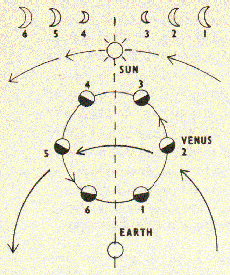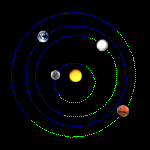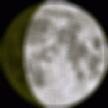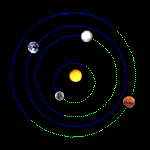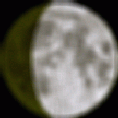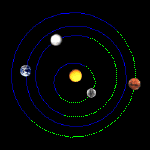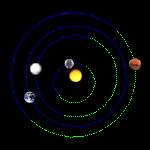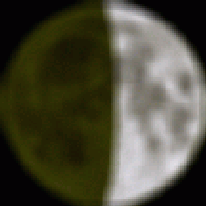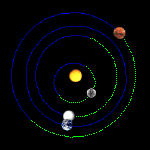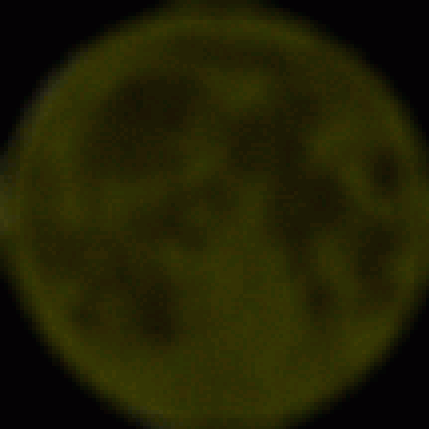Astronomy Group 1996
Project Web Page
Venus
Purpose:
The astronomy group for Hist 333 is composed of Rebecca Brown, Travis Dunn, Karl Haushalter, and Jessica Williams. We observed the planet Venus to complement our observations of the Moon, Jupiter and its satellites, Orion and the Pleiades. We planned to examine the planet with a telescope similar to Galileo's and compare our results with what he observed in the fall of 1610. Specifically, we would like to observe the phases of Venus and the size increase that Galileo recorded.
Background:
In the year 1610 Galileo published his Sidereus Nuncius, a record of his observation of the Moon and Jupiter in 1609 and 1610. In the fall of 1610, Galileo turned his telescope to Venus, which had just become visible after being lost in the sun. The results of his observations began to threaten the cosmological system of Ptolemy, while at the same time provide evidence for the plausibility of the Copernican system. Galileo's announcement of his observations of the phase change of Venus was concealed as an anagram in a letter to the Tuscan ambassador of Prague. Haec immatura a me iam frustra leguntur o y is unscrambled to Cynthiae figuras aemulatur mater amorum. Translated: "the mother of love [Venus] emulates the figures of Cynthia [the Moon]."(Van Helden, p107)
The two systems make different predictions for the progression of the phases of Venus (seen below, Van Helden, p.108). On the left is the prediction of the Copernican opinion, with the planet showing phases similar to the Moon. On the right is the prediction of the Ptolemaic system. In addition, the Copernican system predicts that Venus will change size as the distance between it and the Earth changes, while the Ptolemaic system places Venus at a fixed distance from the Earth. Galileo observations supported the Copernican system and struck another blow to the scientific underpinnings of the Ptolemaic system.
Expectations:
This is how the size and phase of Venus will change over our observing window this semester. Also shown are depictions of the positions of the inner sphere planets. We hope to notice the size of Venus change and, more importantly, we hope to observe the half disk of Venus by the end of the semester.
January 30, 1996
Linear magnification compared to Jan. 30: 100%
February 15, 1996
Linear magnification compared to Jan. 30: 110%
February 27, 1996
Linear magnification compared to Jan. 30: 120%
March 14, 1996
Linear magnification compared to Jan. 30: 135%
March 30, 1996
Linear magnification compared to Jan. 30: 160%
April 15, 1996
Linear magnification compared to Jan. 30: 190%
As a comparison, this is how Venus should appear on June 10, 1996, at its largest.
Linear magnification compared to Jan. 30: 400%
Of course it is impossible to see because it is between the Earth and the Sun.
For some sense of scale
This is about what size Venus would be in our telescope at the end of February.
Results:
Unfortunately, at this point, we have not been able to unambiguously assert that we have observed any the phases of Venus in the Galilean telescope. All through the semester, we have seen Venus in the sky, but we could not determine what the phase was. In our final observation on April 25, we were able to clearly distinguish the shape of Venus in a modern sixteen power telescope, but not in the Galilean telescope. There are three possible reasons for this.
- First, the optics of our telescope may be too poor, and our efforts would be as futile as trying to read with scratched and distorted reading glasses. There is undoubtedly some of this effect. When comparing the view of the Moon with our modern telescope to that of the Galilean telescope, the modern telescope is clearly better, and part of the reason is the optics are obviously superior.
- Second, we may not have enough magnification to see the phases of Venus. Galileo had a twenty power telescope to observe these phenomena, and ours is only nine power, so it is possible that with a more powerful telescope, the phase of Venus will be apparent.
- Third, our aperture may simply be too large. This problem is the easiest to correct. We made two aperture stops, which are simple pieces of cardboard with a circle cut out of the middle. One has a 25 mm diameter, and the other has a 15 mm diameter. The aperture stops are useful because they do not interfere with magnification, but simply cut down on the light entering the telescope. Venus is such a bright object that there is a tremendous amount of glare around its disk. Galileo encountered a similar problem. If you could cut down on the amount of light entering, then the glare goes down. Galileo's solution was also to use aperture stops (Van Helden, p 14). We had hoped that with the aperture stops in place, Venus' phase would be observable to us in the Galilean telescope.
Our last observing attempt of Venus was on April 25. We observed the planet with the Galilean telescope and the modern telescope, using all three possible aperture sizes: no stop, 25mm stop and 15mm stop. The phase of Venus could not be discerned conclusively on any of the three aperture sizes with the Galilean telescope. In all three cases Venus had too much glare surrounding it to clearly make out the shape. Knowing what to look for and expect, we were willing to believe we could see the phase, but without prior knowledge of what it should have been, we cannot say we would have noticed it. In the modern telescope it is a different case. With the 15mm stop in place, there was no doubt on the part of Karl and Travis that the phase could be discerned. Venus appeared to be just slightly over half full, which is not what predicted. On the other two aperture sizes, it was not so clear, but knowing what to expect led us to believe we could just make out the phase. Only with the modern sixteen power at 15 mm aperture was the phase of Venus unequivocally determined. In all other cases there was too much glare to be certain.
In our opinion, our failure is either a magnification effect or possibly an optical defect. The fact that Venus still showed lots of glare with the 15mm stop in the Galilean but not in the modern suggests optical defects of some sort. However, Venus is still very small in both telescopes, so magnification is also a factor. A more powerful Galilean telescope would likely reveal the phase.
Further work:
The most obvious improvement would be a more powerful telescope with better optics. It is not obvious that the phases of Venus can be resolved with a nine power device. Of course, we have only gotten one decent look with Venus, so perhaps when Venus assumes a more crescent appearance we might be able to note the phase change. At this point, it is still very much an uncertainty. Hopefully, one of the group members will be able to make more observations over the summer as Venus moves into its crescent phase.
Sources:
Galilei, Galileo. Sidereus Nuncius or the Sidereal Messenger. Trans. and annotated by Albert Van Helden. Chicago: University of Chicago Press, 1989.
Data on the size and phase of Venus from:
Nautical Almanac Office, United States Naval Observatory, Secretary of the Navy, United States Congress. The Astronomical Almanac for the Year 1996. Washington: U.S. Government Printing Office, 1995.
Images
The astronomy group also owes a tremendous debt of thanks to Dr. Albert Van Helden and Tom Williams for their knowledge and assistance.
Last updated 4/29/96
tdunn@owlnet.rice.edu
Last Revision: July 9, 2001
Electronic Text Center: etext@rice.edu.

